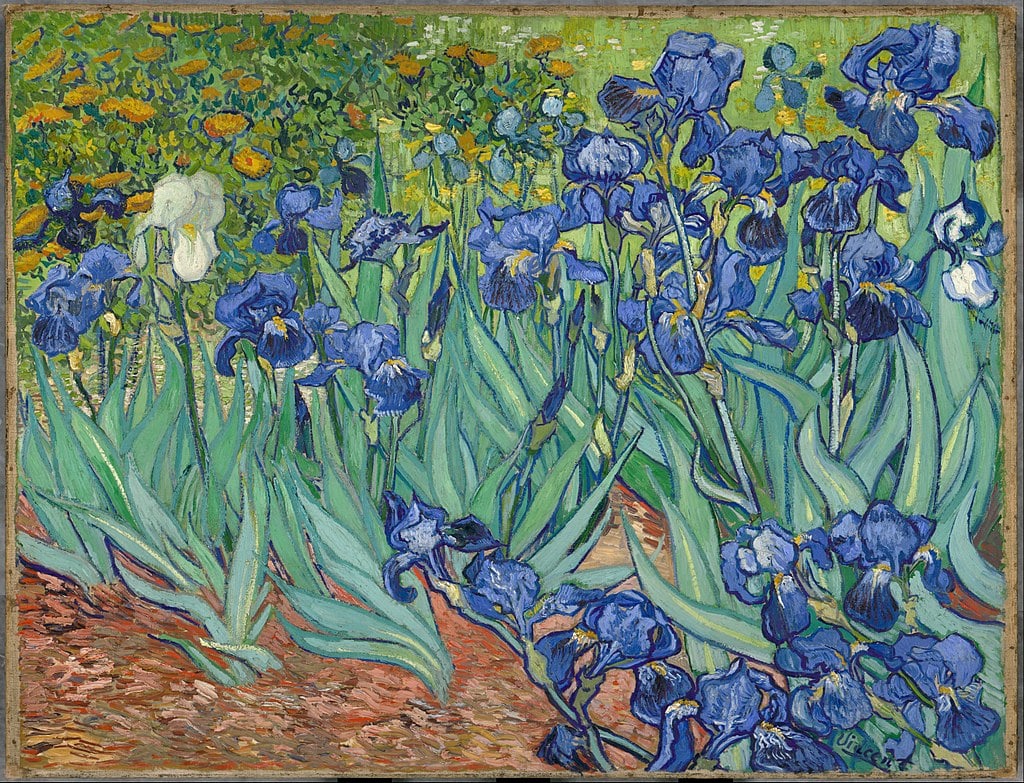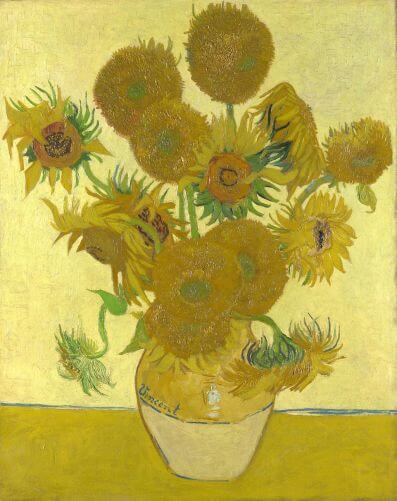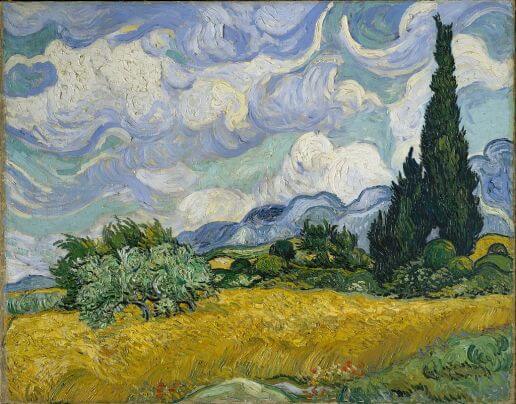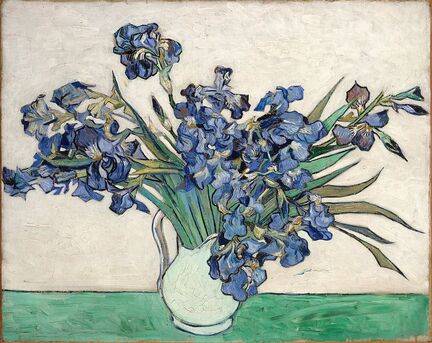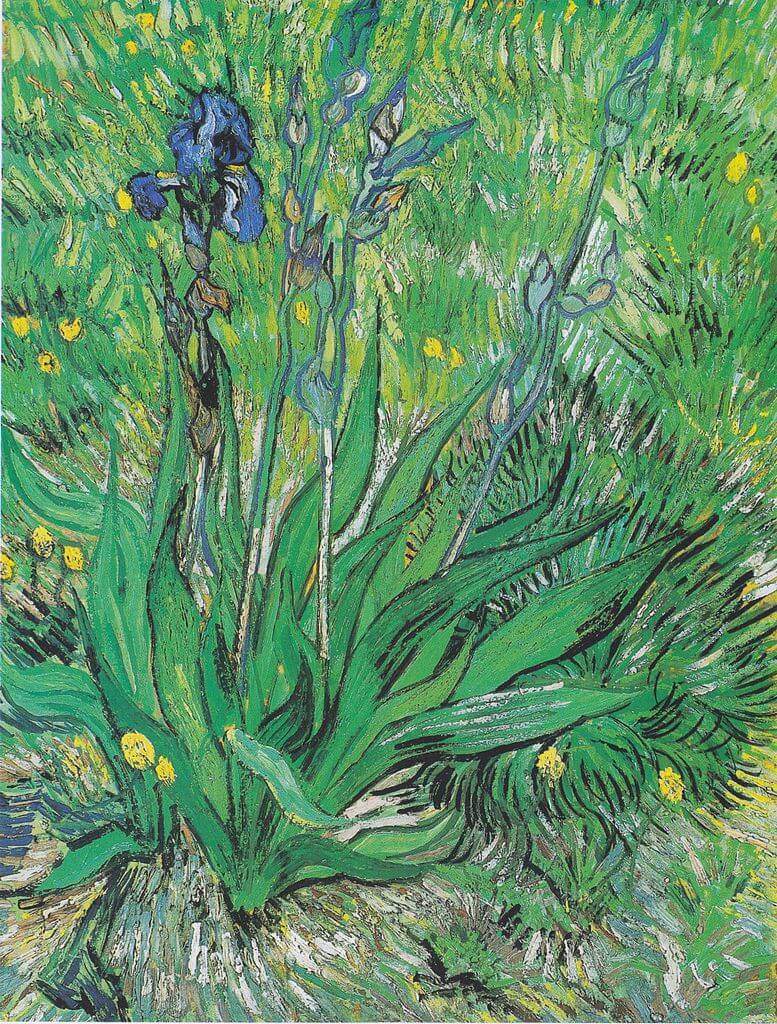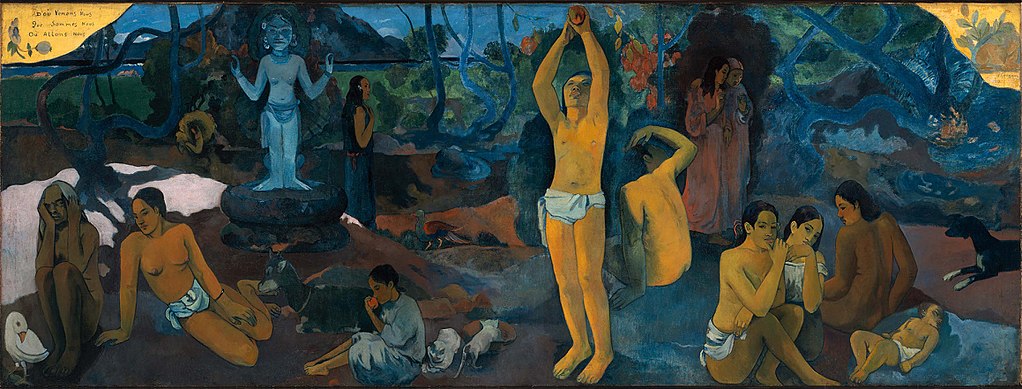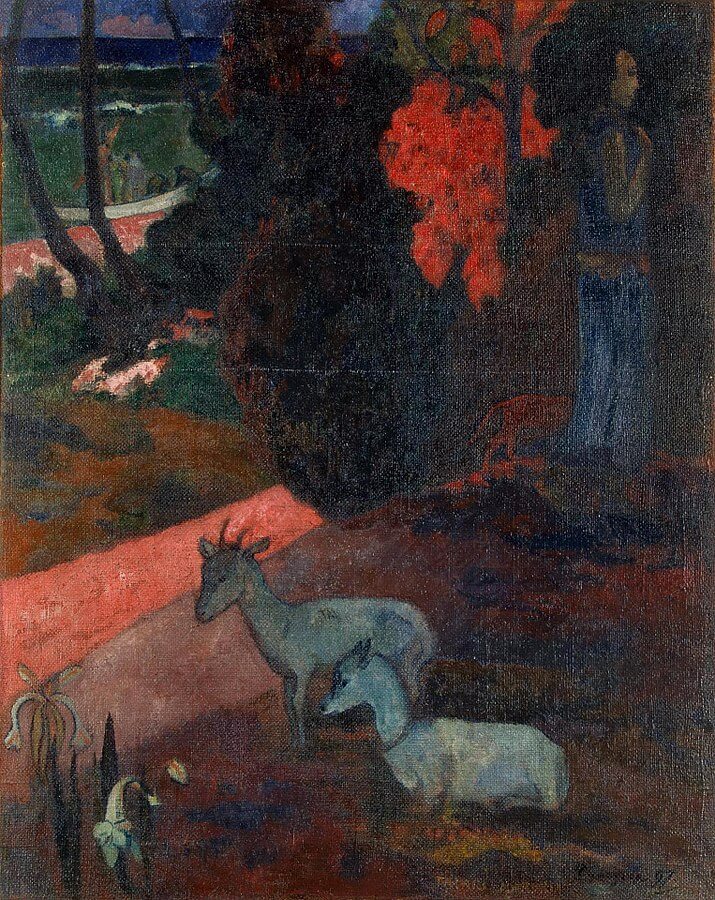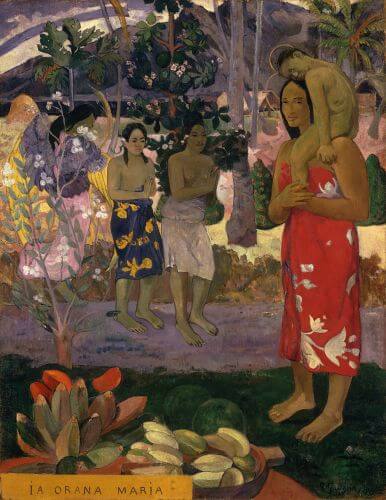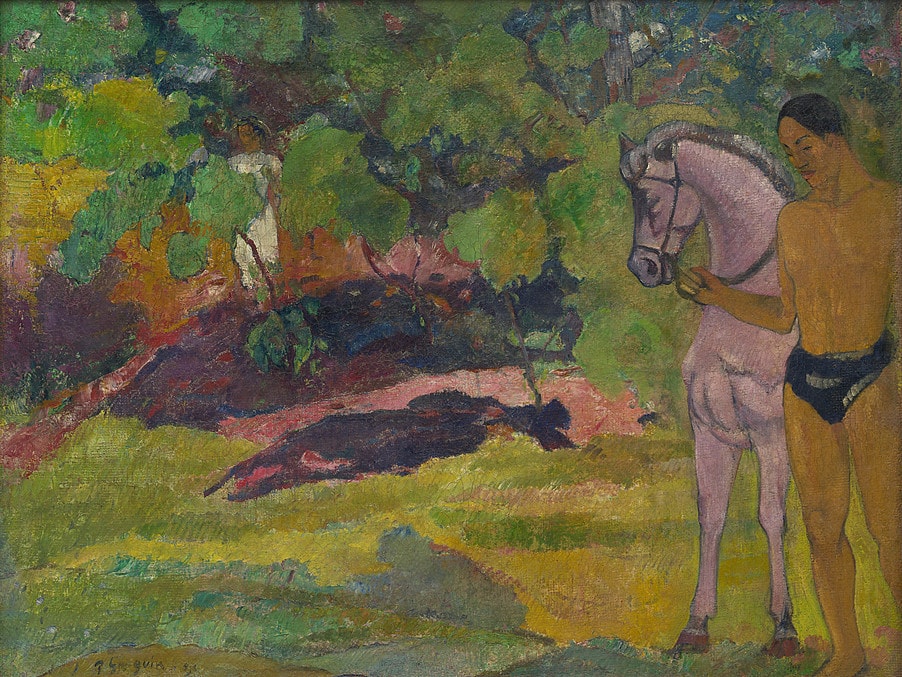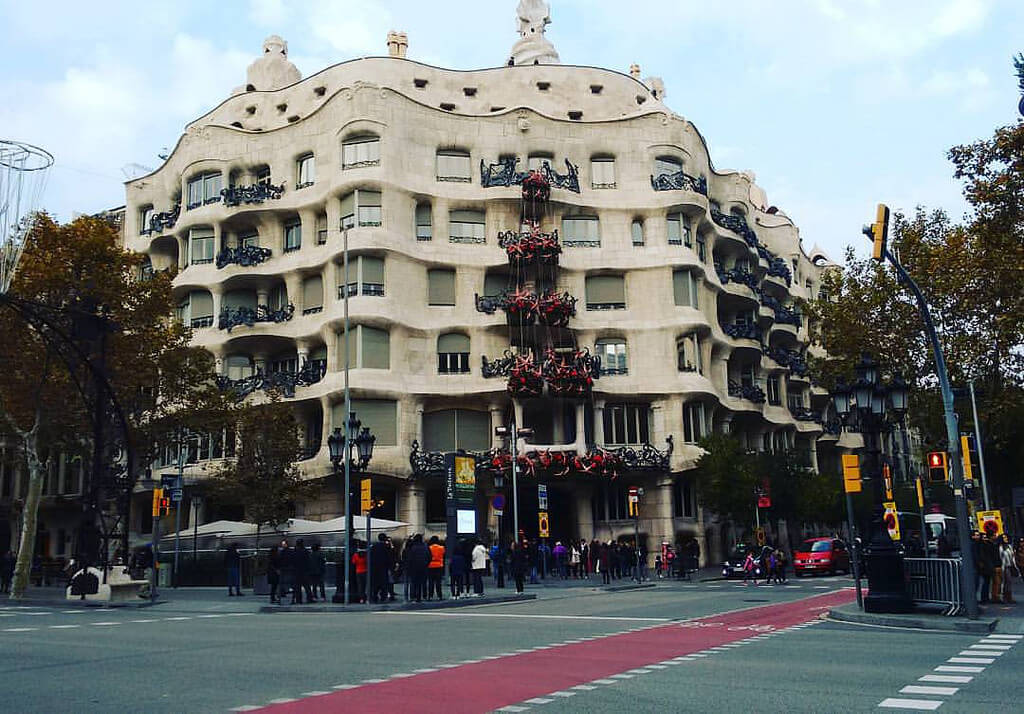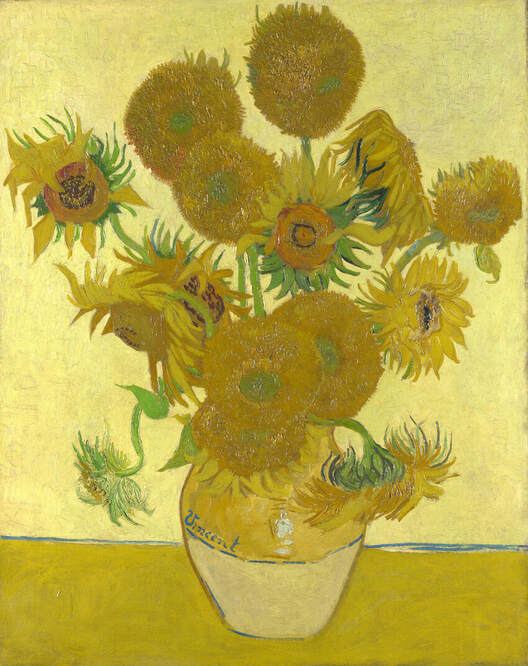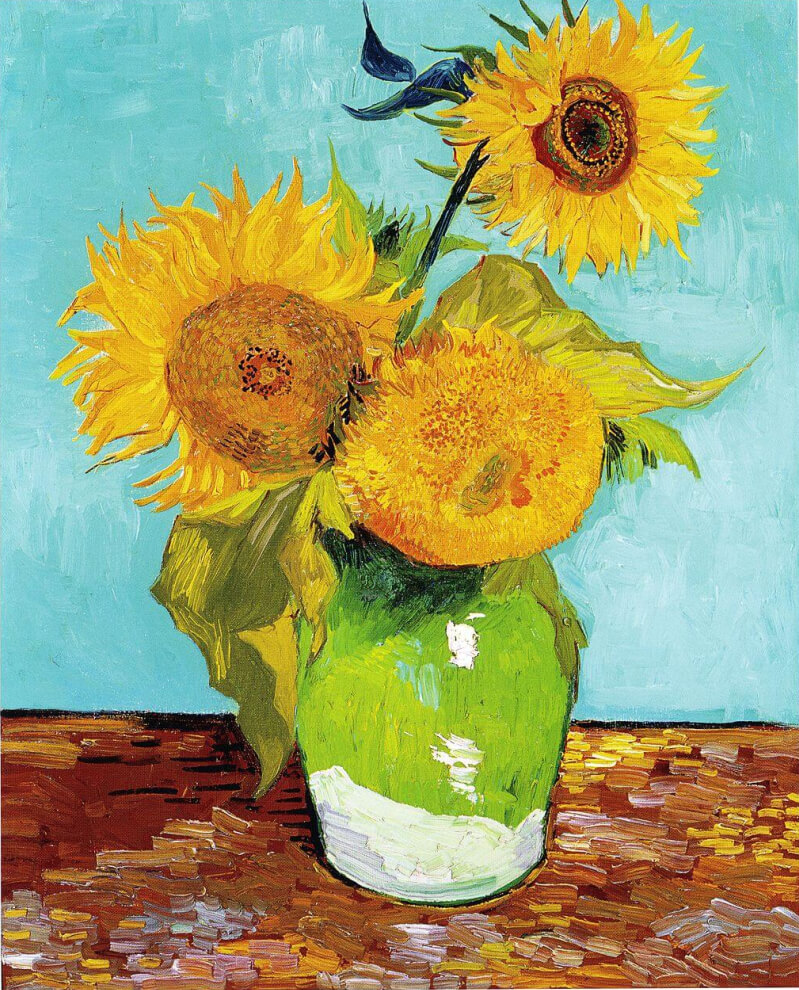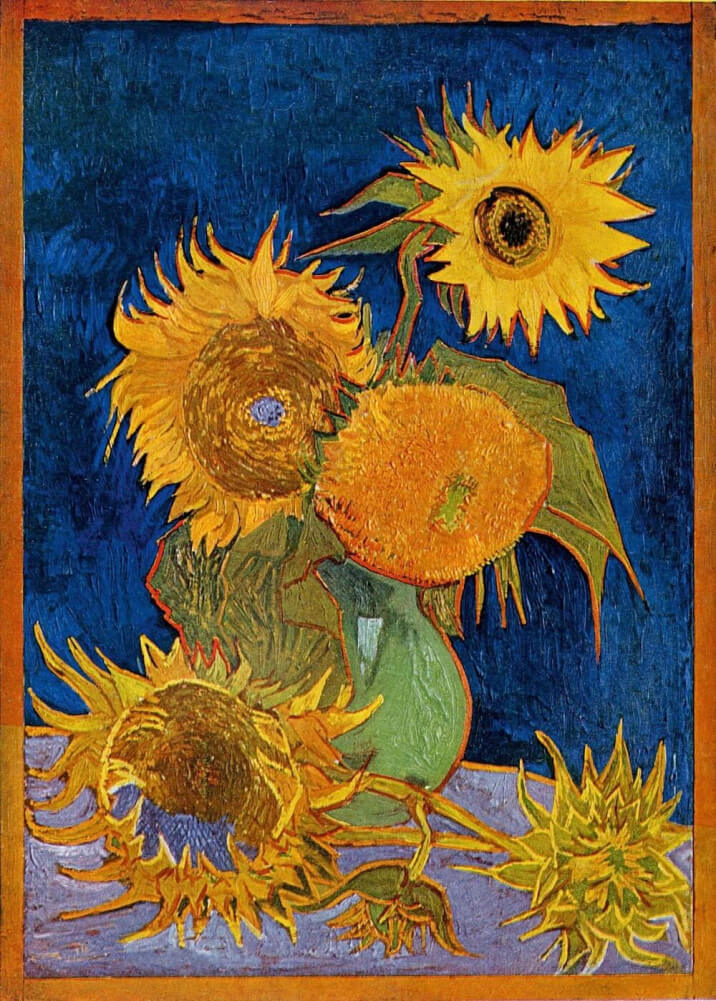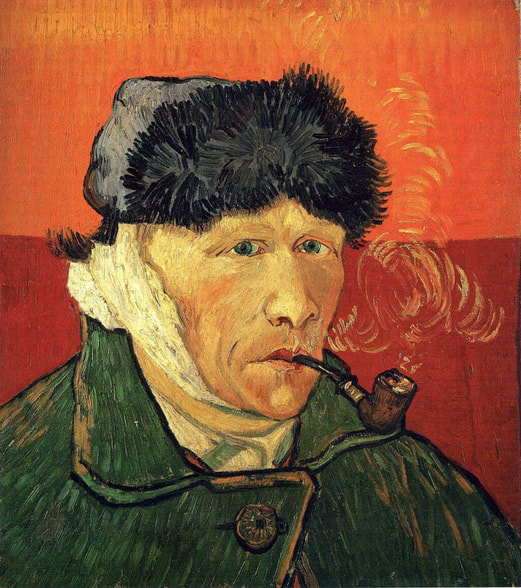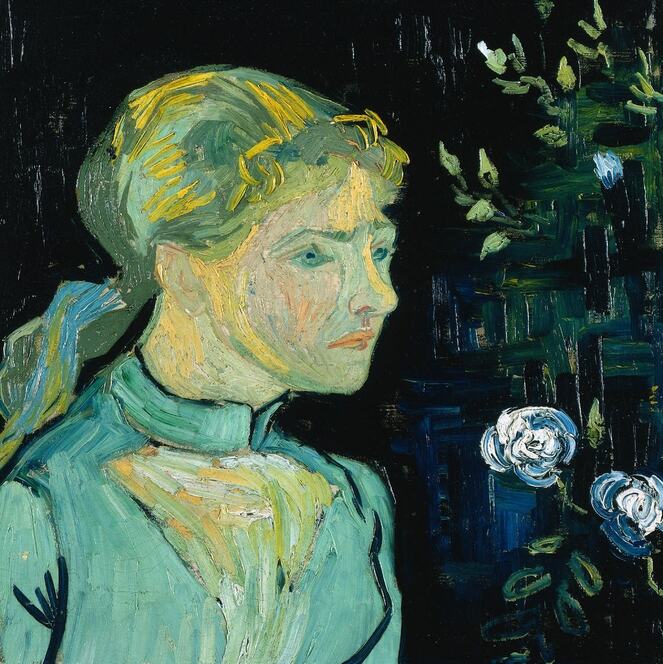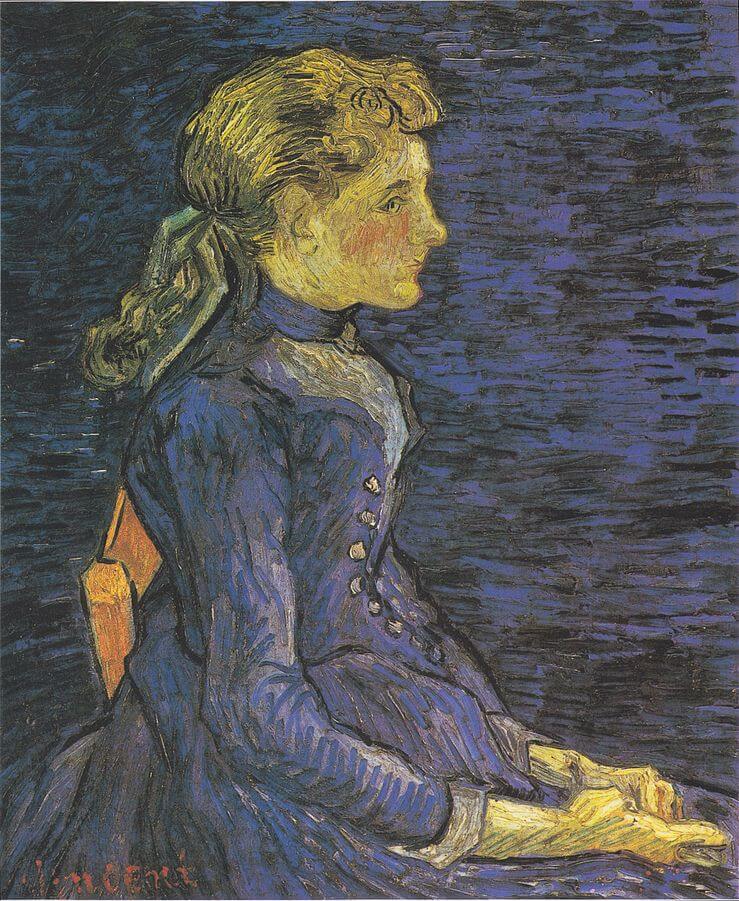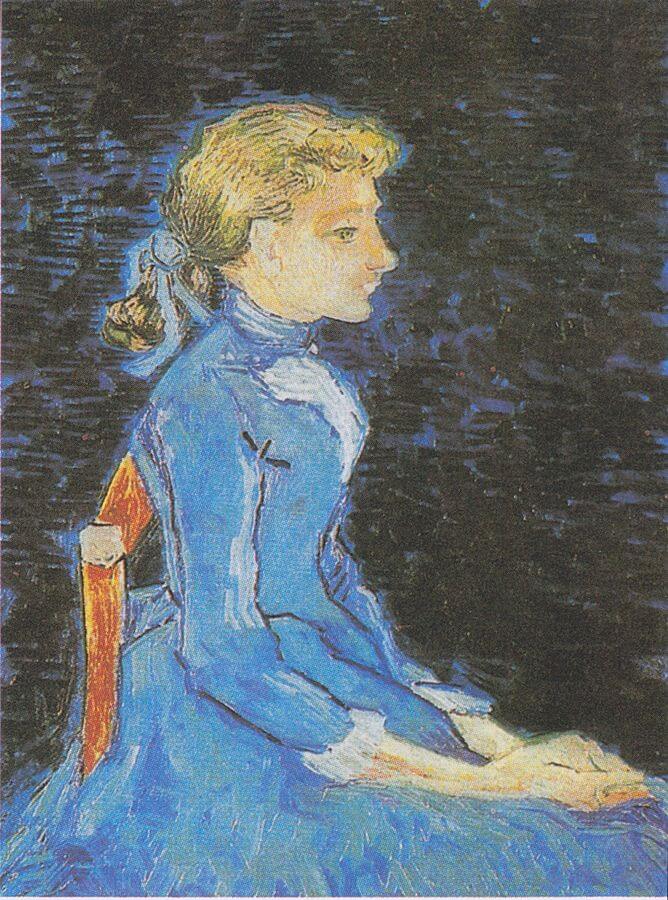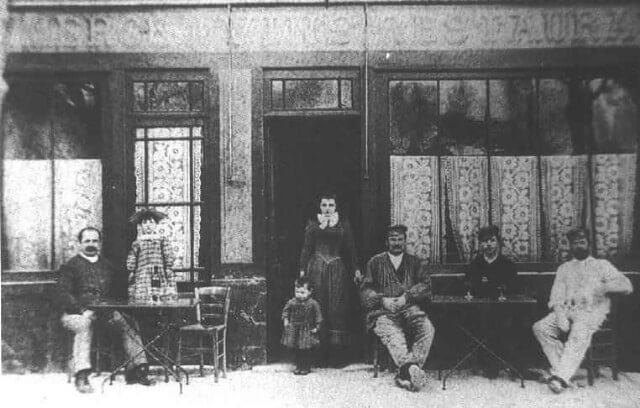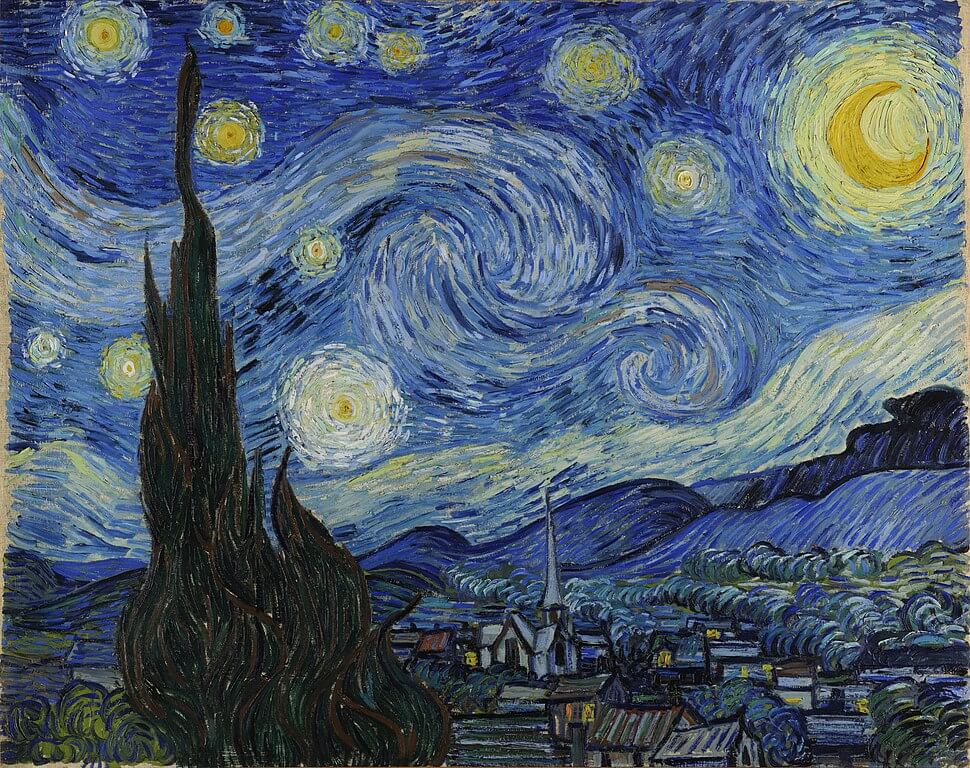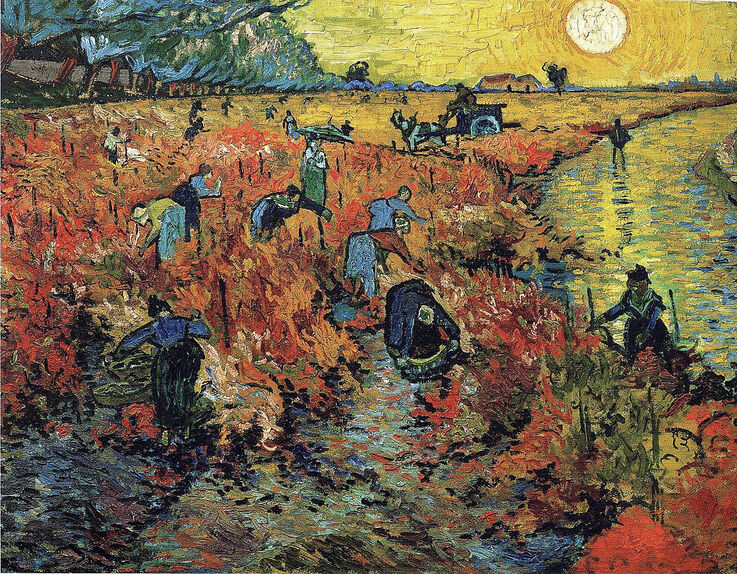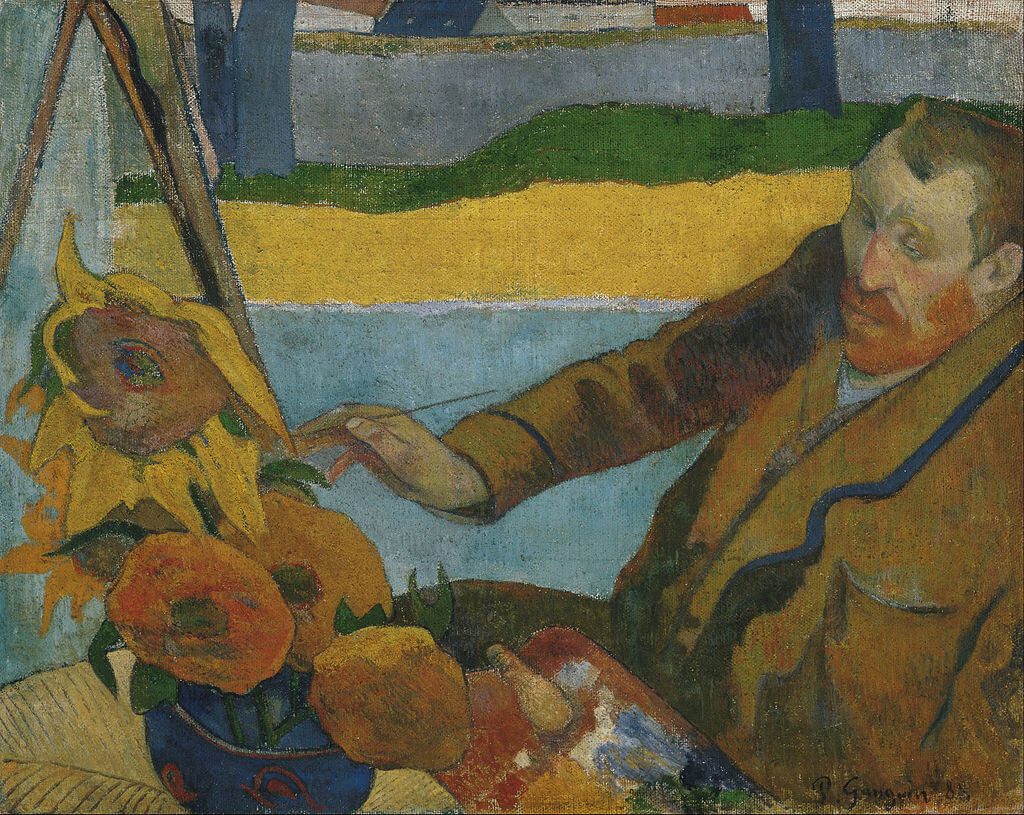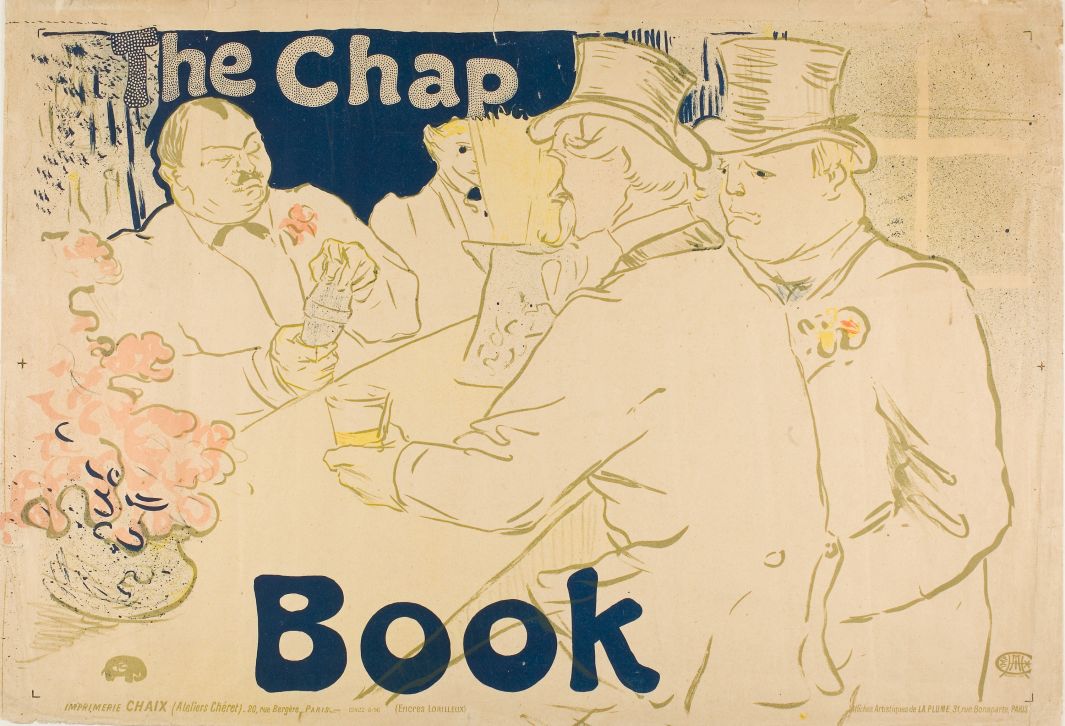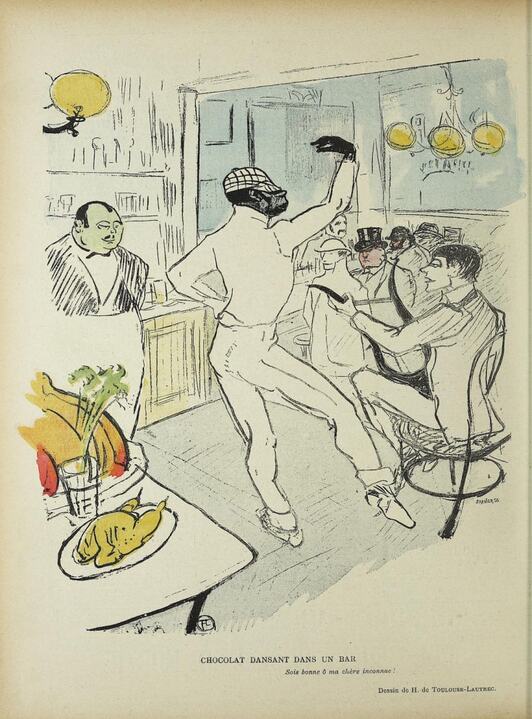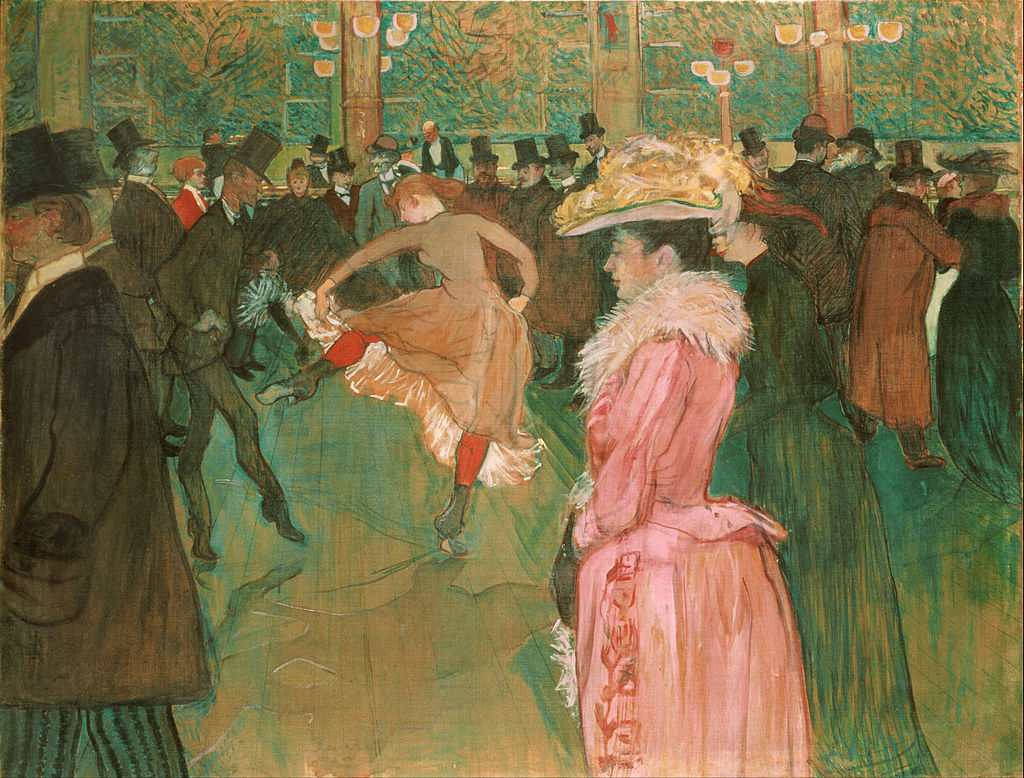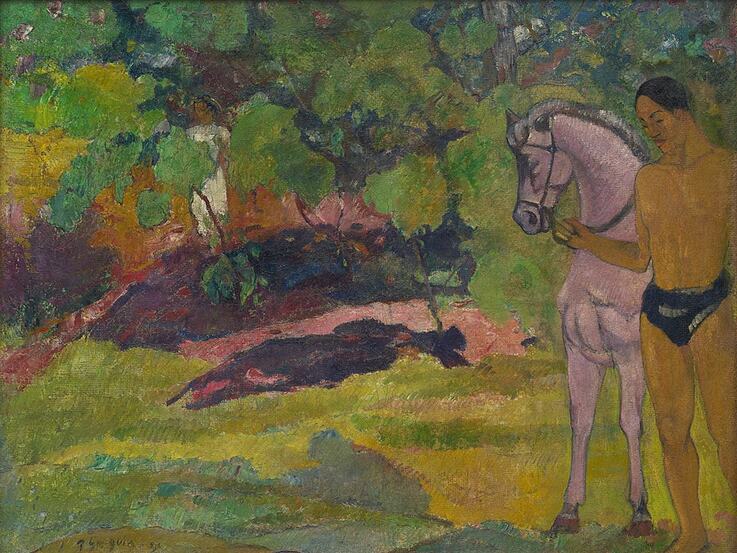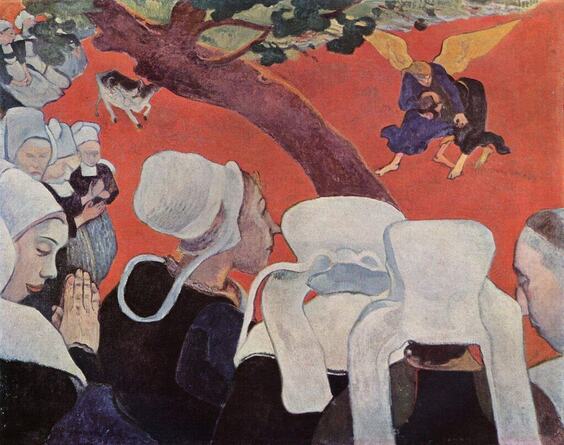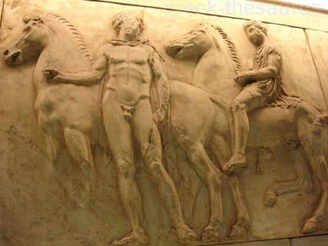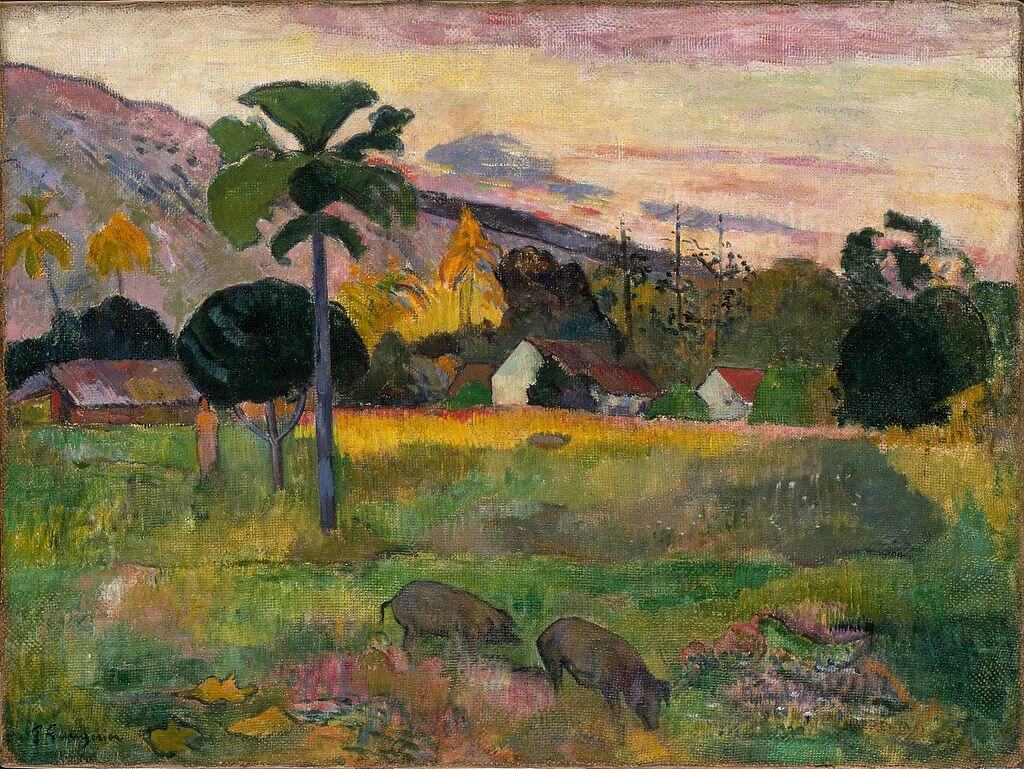|
Where? Room W204 of the Getty Museum
When? 1889 What do you see? In the foreground are blooming blue irises with green stems and leaves with pointy tips. One the left is a single white iris with large petals. In the background are orange marigolds. The flowers are planted in the red-brown earth. On the top right is a meadow lit up by the Mediterranean sunlight. Van Gogh used bright blue and violet colors for the irises and this color contrast nicely with the other colors in this painting. The contrast makes the flowers stand out and makes the flowers come alive. Van Gogh also used the contrast in texture, and you can see that the different elements in this painting have their unique look and texture. For example, the earth in the foreground has a rough texture which contrasts nicely with the smooth texture of the stems and leaves of the irises. The somewhat disorganized petals of the irises also contrast with these smooth leaves and stems. The marigolds in the background have again a different texture. Van Gogh was probably sitting on the ground while painting these irises, which emphasizes the presence of the green stems and leaves. Backstory: Van Gogh painted this work several days after he was admitted to the mental asylum in Saint-Rémy-de-Provence, France. In his first letter from the asylum to his brother Theo, Vincent wrote that he was focusing on painting irises and lilies. These colorful flowers may have provided him with feelings of hope that may have helped him temporarily with his mental state. However, one year after he was admitted to the asylum, he died because of a self-inflicted gun wound. Van Gogh's death was the result of a troubled life, though not everybody could understand that. Monet commented on the death of Van Gogh that he could not understand how a man that loved flowers so much and could depict them in such a beautiful way could be unhappy with his life. What are irises? There are almost 300 different types of irises. The iris exists in many different colors, explaining its name which is derived from the Greek word for rainbow. The most common color for irises is violet-blue, which is the color of the irises depicted in Van Gogh’s painting. The iris can grow from a root or a bulb. Irises have a long stem and one or more six-lobed petals. For bearded irises, the type depicted in this painting, three of these petals curve up and the other three bend down. These irises grow up to about 120 centimeters. Why irises? The simplest explanation is that irises where blooming in the garden of the asylum to which Van Gogh was admitted. Van Gogh was not allowed to leave the asylum and its garden in the first month, so the availability of the blooming irises was a good reason to paint them. Another reason that he painted irises was that Van Gogh loved flowers and flower paintings. Flowers are colorful, and they allowed Van Gogh to experiment with different colors. Van Gogh liked to play around with different colors to provide contrasting effects and to make certain elements in his painting stand out more. His use of colors was inspired by Eugène Delacroix, who he called ‘the greatest colorist of all.' A third reason is that flowers were a popular subject among the masses and Van Gogh hoped throughout his career for some commercial success (which he never got during his life). Who is Van Gogh? Vincent Willem van Gogh was born in 1853 in Zundert, The Netherlands. He only started to fully focus on painting in 1883. In 1886 he moved to Paris, and, two years later he moved to the south of France, to Arles. He struggled with mental illness and died in 1890 from the results of a self-inflicted gunshot wound. Most of Van Gogh’s famous paintings come from the last three years of his life. Examples include his famous series of sunflowers, of which one version is in the National Gallery in London. Another example is his Wheat Field with Cypresses in the Metropolitan Museum of Art (he made two other versions of that painting, one in the National Gallery and another in a private collection). His later work can be characterized by broad brush strokes, the unique combination of colors, and the use of innovative perspectives and designs.
Fun fact: Irises was sold in 1987 for a record-breaking fee of $53.9 million to the Australian businessman Alan Bond. However, he failed to repay a substantial loan he got from the auction house, and the painting was resold in 1990 to the Getty Museum.
Van Gogh created more paintings with irises as the main subject. In the Metropolitan Museum of Art hangs the painting Irises and the Van Gogh Museum in Amsterdam has another version of a vase with irises. The National Gallery of Canada exhibits Iris, a painting with a single iris.
2 Comments
Where? Gallery 255 of the Museum of Fine Arts
When? 1897-1898 What do you see? This painting shows a story on the cycle of life. It consists of three parts corresponding to the three questions in the title of the painting.
Backstory: The French title of this painting is D'où Venons Nous? Que Sommes Nous? Où Allons Nous? Gauguin included this title on the top left of the painting. A valuable source of information to understand this painting are the letters that Gauguin wrote to George-Daniel de Monfreid, an art collector and painter in France. Based on these letters, we know that when Gauguin started to work on this painting, he was in a dark period of this life. He faced quite some debt, bad health, the death of his favorite daughter, and he wanted to kill himself. However, before dying, he wanted to complete a large canvas about the meaning of life. For about one month, he worked day and night on the painting. When it was finished, he considered this to be his best work ever and wrote that he would never make a better painting. Some other works that he completed during this dark period of his life are the Landscape with Two Goats (also known as Tarari Maruru) and Man Picking Fruit from a Tree. After Gauguin completed the Where Do We Come From painting, he attempted suicide but failed at it. The painting was exhibited in 1898 in Paris and received mixed reviews. In 1901, the painting was sold for 2500 French Francs (which is equivalent to about $15,000 today).
Who is Gauguin? Eugène Henri Paul Gauguin was born in 1848 in Paris, France, and died in 1903 in French Polynesia. Gauguin is considered to be a Post-Impressionist artist, though his work differs from the Post-impressionists by the unique colors that he used and the feelings he expressed in his paintings. Just like paintings by Van Gogh, who was a friend of Gauguin, the works of Gauguin are often recognizable from a distance.
Gauguin was only a full-time artist during the last 20 years of his life. Until the crash of the French stock market and the art market in 1882, Gauguin was a successful stock and art broker, yearly making the equivalent of about $250,000 today. In 1891, he decided to move to Tahiti in French Polynesia where he stayed for two years. Upon his arrival, he created some of his famous paintings, like Hail Mary in the Metropolitan Museum of Art and In the Vanilla Grove, Man and Horse in the Guggenheim Museum in New York. After an unsuccessful return to France for two years, Gauguin returned to French Polynesia where he lived until his death.
Fun fact: This painting is featured in the book Origin (Amazon Link) by Dan Brown. In the book, the painting hangs in Casa Mila in Barcelona, which was a private house designed by Antoni Gaudí. The painting refers to the search for the existential questions of ‘where do we come from?’ and ‘where are we going?’. The painting by Gauguin does not answer these questions.
Gauguin kept the painting and symbolism in this painting quite vague to stimulate the viewer to think about these questions. That has certainly worked for some people in Dan Brown’s book as some characters are actively looking for the answers to these questions.
Where? Room 43 of the National Gallery
When? 1888 What do you see? A total of 15 sunflowers is depicted. The sunflowers are actually dying, and you can see that almost half of the sunflowers does not have any petals left. Specifically, six sunflowers only have their flower head left, and the sunflower on the top right only has a single petal on it. This is an indication that they are at the end of their life. The sunflowers that we often adore are the ones with the petals still on it, and in combination with the flower head, they make the sunflower look like a sun with rays. The petals of the sunflowers that still have them are quite spiky. Notice also the colors that Van Gogh used. Besides some green, he used different shades of yellow. It is very difficult to create a painting with a clear subject and interpretation with such a limited array of colors, yet Van Gogh succeeded in creating a painting of sunflowers that can be recognized from a large distance. This still-life painting beams of the wall and energizes people around the world, something that is very uncommon for still-lifes which are often considered to be somewhat dull. Backstory: A painting of sunflowers is immediately associated with Van Gogh. He created a total of 11 paintings of sunflowers. The first series of four paintings shows sunflowers lying on the ground and the second series of seven paintings shows sunflowers in a vase. This second series contains four originals which he created in a single week. Van Gogh also made three copies of the paintings in the second series. Two of these three copies are copied from the Sunflowers version in the National Gallery. One of these copies is currently in the Van Gogh Museum in Amsterdam, and the other copy is in the Seiji Togo Memorial Sompo Japan Museum of Art in Tokyo (this version was sold for almost $40 million in 1987, making it the most expensive painting ever sold at that time). Sunflowers for Paul Gauguin: Van Gogh’s idea was to create these sunflower paintings as a decoration for the room of Paul Gauguin who would join him in Arles to paint. He knew that Gauguin liked sunflowers as, in the year before, Gauguin had exchanged one of his paintings for two of the earlier sunflower paintings of Van Gogh. Van Gogh was very excited that Gauguin would visit him and was in a fantastic mood when he created his second series of sunflower paintings. When Gauguin arrived, he was indeed impressed by these paintings and even Van Gogh himself was quite happy with the results (which was uncommon for him). The interest of Van Gogh in flowers was probably stimulated by his nationality as flowers are a very big part of the culture in The Netherlands. In fact, The Netherlands is the biggest flower exporting country in the world.
Symbolism: These sunflowers also have a symbolic value (though it is not clear how important this symbolic value was to Van Gogh). Flowers are a symbol of life. They have a period in which they bloom beautifully and they are in their prime, but eventually, they die. The cycle of a flower’s life is often used as an analogy for human life and should remind us of our own mortality. However, inside the flower head are the seeds of new life. These seeds refer to the cycle of life on this planet.
Who is Van Gogh? Vincent van Gogh (1853-1890) was born in Zundert in The Netherlands. He only started his artistic career in 1881 and so all the works we know from him are made within one decade. For many of his later paintings, Van Gogh studied a landscape, the sky, or some flowers in front of him while working on the painting. He liked to be outside while painting. His favorite color, which you can see in many of his paintings, is yellow. He considered yellow to be the color of life (as the sun is also yellow). Van Gogh developed a unique style of painting, which is very recognizable. Especially in his later years, he applied thick layers of paint to the canvas and used heavy brushstrokes. His work appeals worldwide to many people that are otherwise not so interested in art. Fun fact: Van Gogh’s idea was to create a painting community in Arles, where he moved in February 1888, but nobody wanted to join him there initially because of his difficult personality. However, the brother of Vincent convinced Paul Gauguin to join him and Vincent was very excited about this. On October 23, 1888, Gauguin joined Van Gogh in Arles. But the collaboration did not turn out well and Gauguin left in December 1888. According to Gauguin, Van Gogh threatened him with a razor and Gauguin ran away. That same night Van Gogh mutilated his own ear with a razor blade, which caused severe bleeding. He applied a bandage to his ear and packaged his ear in a piece of paper, which he brought to a woman in the brothel nearby that he frequented. He painted a self-portrait with a bandaged ear and pipe which is currently in a private collection.
Written by Eelco Kappe
Where? Gallery 222 of the Cleveland Museum of Art
When? 1890 What do you see? A portrait of Adeline Ravoux, the daughter of the innkeeper from whom Van Gogh rented a room. Adeline wears a blue dress with a high collar, a white bodice under it, and a blue ribbon in her hair. The color of the dress matches her blue eyes. While she was 12 years old when Van Gogh created this painting, she looks much older. This was actually the idea of Van Gogh, as he wanted to portray her as the woman she would become. Her expression is a bit aggressive or unhappy, which may imply that she hears about her future as a woman. On the right are two white flowers and a series of green leaves floating in the air. The white flowers may symbolize purity and innocence and may also refer to her future as a married woman. Backstory: Van Gogh created this painting one month before he committed suicide. He based this painting on an earlier work for which Adeline had posed. His idea was to develop a new style of portrait painting. As he wrote to his brother: “I should like to paint portraits which would appear after a century to the people living then as apparitions.” In other words, he wanted to create a ghostlike image of his sitters. To his sister Van Gogh wrote: “So I don’t try to do us by photographic resemblance but by our passionate expressions, using as a means of expression and intensification of the character our science and modern taste for color.” Other versions of Adeline Ravoux: Van Gogh made two other portraits of Adeline Ravoux, which are both in private collections. In one portrait of Adeline Ravoux, she is shown from the thighs up. This is the only portrait that he signed as he gave it to Adeline’s family. He created the portrait in a single afternoon. He made a copy of this painting, using lighter colors for the dress, which he gave to his brother Theo.
Who is Adeline Ravoux? She is the daughter of Arthur Gustave Ravoux, who was an innkeeper at Auberge Ravoux in Auvers-sur-Oise, about 20 miles North of Paris. Van Gogh spent the last 70 days of his life in this inn. Adeline Ravoux is prominently featured in the movie Loving Vincent. Van Gogh wrote in a letter that she was probably 16 years old at the time of the painting, but she was actually only 12 or 13 years old.
Loving Vincent: In 2017, the movie Loving Vincent was released. It is an animated film, based on paintings by Van Gogh. The movie took six years to produce. It takes place one year after the death of Van Gogh and uses characters who Van Gogh painted. As he painted Adeline Ravoux three times, she plays an important role in the movie. The movie was nominated for an Oscar but did not win one. Auberge Ravoux? Nowadays, Auberge Ravoux is better known as Maison de Van Gogh. It is open to visitors who can see the room in which Van Gogh spent his last nights. Van Gogh spent less than a dollar per day to stay in a room of seven square meters (75 square feet). This fee included meals. After Van Gogh died, the room was never rented again. There is nothing in that room that remembers of Van Gogh’s stay, which is also reflected in the slogan of the Maison de Van Gogh: “There is nothing to see… but everything to feel.” The picture below shows the Auberge Ravoux in 1890. The person on the left is the owner, Arthur Gustave Ravoux, and Adeline Ravoux is the girl standing in the door opening in the middle.
Who is Van Gogh? Vincent Willem van Gogh (1857-1890) was a Dutch painter who lived most of his painting career in France. He only started painting seriously in 1881 and created almost 900 paintings, of which he completed most during the last two years of his life. He is a Post-Impressionist painter who created mainly landscapes, portraits, and still lifes.
In 1886, Van Gogh moved to Paris, where he met Paul Gauguin, among others, and these meetings inspired the rest of his painting career. He started to paint more colorful works. Famous works include his series of sunflowers, of which one version is in the National Gallery in London and The Starry Night in the Museum of Modern Art in New York.
Fun fact: Adeline Ravoux has described in a book by Dr. Tralbaut what she remembers of the day that Van Gogh shot himself. In short, she remembered that Van Gogh had lunch at the inn and that nobody noticed anything unusual about him. However, that day, he had borrowed the gun of Gustave Ravoux, the innkeeper, to scare off the crows that would get to close to his canvas while painting in the fields.
In the evening Van Gogh came back to the inn later than usual, and he quickly went up to his room. When the innkeeper entered his room, he told him that he had shot himself and that he would like to have his pipe and tobacco. He died two days later in the presence of his brother Theo.
Where? Second floor of the Department of 19th and 20th Century European and American Art in the Pushkin Museum
When? 1888 What do you see? The vine harvest in Arles, in the South of France. On the top right is the sun in a yellow sky. The sunlight affects the landscape, starting with the gold-colored river on the right side. The sun makes the vine leaves in the bottom half of the painting look red. According to a letter written on November 6, 1888, by Vincent van Gogh to his brother, the vineyard looked like red wine in the sunset. The vineyard in the top half of the painting looks yellow, just as Van Gogh observed it during his stroll through the vineyards. A large number of people, mainly dressed in blue, is working in the vineyard. The workers in the background are depicted as blank silhouettes. The field workers are picking vines during fall. They naturally blend in with the vineyard. On the top left is a series of blue and green trees and in the middle background is a house. Van Gogh used several diagonal lines in his composition and most viewers naturally start looking at the sun when viewing the painting. The viewers’ eyes then move down along the diagonal black line on the left of the river in the direction of the bottom left of the painting. Backstory: This painting is also referred to as The Red Vineyard at Arles. Van Gogh created it in a single day on November 5, 1888. He painted this work about two weeks after Paul Gauguin joined him in Arles. The colorful works of Gauguin inspired Van Gogh to also use more colors for this painting, and he continued to do that in his later works. Van Gogh created this painting from his memory, the day after an evening walk through the vineyards near Arles. Van Gogh liked to work from memory rather than by directly painting from observation as painting from memory gives paintings a more artistic look. The only painting that Gauguin completed during his two-month stay in Arles was The Painter of Sunflowers (Portrait of Vincent van Gogh) which is in the Van Gogh Museum in Amsterdam. In September 1888, Van Gogh also created another painting of the vineyards, called The Green Vineyard. This painting is on display in the Kröller-Müller Museum in The Netherlands.
Symbolism: The main message of this painting is that the people living at the end of the 19th century had to work long days. The workers in this painting are still doing manual labor during sunset at the end of the day. Van Gogh also liked the field workers as they were in sync with nature.
Who is Van Gogh? Vincent Willem van Gogh (1853-1890) was born in Zundert in the south of The Netherlands. He was the oldest of six children who survived birth and grew up in a very religious family. Vincent wanted to become a pastor, like his father, but failed the entrance exam. Instead, he worked for some time as a missionary. His career as an artist was relatively short. Van Gogh only started painting at age 27 on the advice of his brother. In 1888, Gauguin visited Van Gogh in Arles. In anticipation of his visit, Van Gogh created his famous series of sunflower paintings. One of the versions of the Sunflowers is in the National Gallery in London. Another famous painting by Van Gogh, created in 1889, is The Starry Night which is in the Museum of Modern Art in New York.
Fun fact: Van Gogh created about 900 paintings and 1100 drawings during his relatively short career but only sold one painting (at least according to official records). In 1890, he sold The Red Vineyard at an art show in Brussels for 350-400 Belgian Francs to the Belgian artist Anna Boch. This is equivalent to about $1,500 today.
In 1906, Anna Boch sold the painting for 10,000 Belgian Francs to the Russian art collector Sergei Shchukin. The brother of Anna Boch, Eugène Boch, was a friend of Van Gogh. There are theories that Van Gogh may also have sold a few other paintings, but clear evidence for those theories lacks. During his life, Theo, the brother of Vincent van Gogh, supported him financially and tried to promote his work as he was an art dealer. However, Van Gogh’s work was different from the popular Impressionist paintings at that time and was not much in demand. There were a few art critics and artists that appreciated his work, but he was ahead of his time for most of the rest of the people. After his death, his works became much more popular.
Where? Room 10 of the San Diego Museum of Art (fourth drawer of the most-left cabinet)
When? 1895 Commissioned by: The magazine La Plume on behalf of The Chap-Book in Chicago What do you see? An advertisement poster for the American literary magazine The Chap-Book. The scene is the Irish and American Bar in Paris. An anonymous man with a large mustache sits at the bar with a drink. The iconic barman Ralph is preparing a drink for Tom, the driver of the horse-drawn carriage of the Rothschild family, who just arrived. The half-Chinese, half-American-Indian barman was born in San Francisco and known for his special cocktails. Both Ralph and Tom have a floral decoration on their jacket. In the background, another anonymous man stands behind the bar. The bottom of the poster lists, in small print, the printer (Imprimerie Chaix) and the magazine (La Plume) in which this poster is advertised. What is The Chap-Book? The Chap-Book was an American magazine published between 1894 and 1898. Every two weeks, an issue was published containing several short literary stories. An issue cost 5 cents in 1895 and contained, on average, about five short stories. Backstory: The Irish and American Bar was located at the Rue Royale in the center of Paris. The Rue Royale is a short street between the Place de la Concorde and the Place de la Madeleine. The owner of the bar was a Swiss man (Achille) and an Englishman (Reynolds) ran the bar. While Toulouse-Lautrec preferred to hang around in the artistic Montmartre neighborhood of Paris, the Irish and American Bar was among his favorite spots when he wanted to escape Montmartre. When visiting the bar, Toulouse-Lautrec would encounter many other artists. Other people frequenting this place where coachmen who were waiting while their employers would dine in one of the fancy nearby restaurants. Toulouse-Lautrec featured this bar in several posters and drawings, including Chocolat Dancing in the Achille Bar.
Other versions: As Toulouse-Lautrec created the original drawing for this poster on a stone tablet, it could be used to create many prints. Toulouse-Lautrec created two versions of this lithograph. The first version does not have the advertising text, and 100 hundred prints of this version were created for collectors. Some of these prints are now owned by museums like the Museum of Modern Art and the National Gallery of Art.
After the first version was printed on posters, Toulouse-Lautrec added the advertising text and the current poster was printed. Besides the San Diego Museum of Art, prints of this second version are owned by museums like the Art Institute of Chicago. Most museums do not have the lithographs of Toulouse-Lautrec on permanent display as they are sensitive to light exposure. What is Lithography? An image is painted on a smooth metal or stone surface. This surface can subsequently be used to print multiple copies of the original image. Lithographic posters became popular during the end of the 19th century. The recent advances in color printing made it possible to print colored lithographs relatively cheaply. Toulouse-Lautrec was among the artists that picked up lithography. He was able to make good money with these lithographs as the laws on public marketing were relaxed and bars, night clubs, and theaters were now allowed to publicly advertise their business. Who is Toulouse-Lautrec? Henri Marie Raymond de Toulouse-Lautrec-Monfa (1864-1901) came from a French aristocratic family. He suffered from health problems throughout his life and only became 1.42 m (4 ft 8 in) tall. Despite his aristocratic roots, he enjoyed a Bohemian lifestyle in Paris. Even though Toulouse-Lautrec could count on the financial support of his family, he earned his own money as a painter, draughtsman, and illustrator. He was one of the first artists who successfully jumped on the opportunity to create advertising posters. His artistic style was inspired by artists like Degas and Manet. A representative example of his paintings is At the Moulin Rouge: The Dance in the Philadelphia Museum of Art, which he painted in 1890.
Fun fact: Henri de Toulouse-Lautrec loved to spend time in the bar. The Irish and American Bar in this painting was his favorite for some years. He spent so much time there that he invited people that wanted to meet him to the bar. He was typically the last person to leave the bar in the night. He also helped to serve the clients of the bar occasionally. As Toulouse-Lautrec was very short, the owner of the bar had a special platform installed for him such that he could properly serve the clients.
Interested in a copy for yourself? Poster
Where? Part of the Thannhauser collection of the Solomon R. Guggenheim Museum
When? 1891 What do you see? This painting is situated in a small forest in Tahiti used to grow vanilla. The vanilla vines climb up the trees. The majority of the painting is made up by the landscape. In the bottom half of the painting, Gauguin used abstract color areas to depict the grassland. The forest in the background looks more like a tapestry. In the right foreground, a man holding his horse can be seen. The man is only wearing black shorts. He is looking down while waiting and does not have much expression on his face. In between the trees, just left to the middle, a woman dressed in white hides in the forest. It seems that the two people have arranged a romantic meeting (a rendezvous) between them that needs to remain a secret.
Synthetism: This is an artistic style used by artists such as Gauguin and Émile Bernard. It is a combination of different approaches to painting. For example, on the one hand, the real world can be depicted in a painting, while, on the other hand, the artist’s dream world can also be depicted.
As Gauguin was an artist who mainly painted from his imagination, he combined the real world which he saw in front of him with the ideas that he had in his mind. In this painting, he combined the landscape in French Polynesia with a scene in his mind from a man with a horse that was inspired by one of the friezes of the Parthenon. An even better example of this style is the painting Vision after a Sermon by Gauguin. In this painting, several women are leaving the church at the bottom, and they see a vision of Jacob wrestling with the Angel, which was the subject of the sermon.
Who is Gauguin? Eugène Henri Paul Gauguin (1848-1903) was born in Paris. He was a Post-Impressionist painter. He is known for his experimental use of different colors, which has had a big impact on future artists such as Picasso and Matisse.
On April 1, 1891, Gauguin left to Tahiti, which is the largest island of French Polynesia and lies in the middle of the Pacific Ocean. His idea was to escape from the artificial life in France and to immerse in nature, live like a child would do, and focus on his art. The first painting he created on Tahiti is Hail Mary which is now on display in the Metropolitan Museum of Art. At the same time as the painting In the Vanilla Grove, Man and Horse, he also painted Haere Mai, which is also on display at the Guggenheim Museum. Gauguin stayed in Tahiti for two years, before returning to France in August 1893. In 1895, he returned to French Polynesia where he stayed until his death. During his life, Gauguin was often struggling for enough money to be a full-time painter, but his work became very popular after his death.
Tahiti: Tahiti is an island in the middle of the Pacific Ocean. It is formed by volcanic activity and is a part of France. 70% of the total population (which is less than 200,000) consists of indigenous Tahitians. While many people speak the Tahitian language, French is the official language. The island contains a small airport but has direct flights to Los Angeles, Paris, Sydney, and Tokyo. Vanilla is one of the important export products of Tahiti. The island contains a small museum dedicated to Gauguin, appropriately called the Paul Gauguin Museum.
Fun fact: In 1893, Gauguin returned to Paris to sell some of his paintings. During his time there he dressed in traditional Polynesian cloths and started an affair with an exotic teenager. His stay in France was not a success, and his ideas and his reputation were verbally attacked in the Mercure de France magazine by several contemporaries. Disappointed, he returned in 1895 to French Polynesia, where he could focus again on his art without much distraction from the artificial and conventional aspects of life.
Written by Eelco Kappe
|
Categories
All
|
- Home
- Blog
-
Museums
- Alte Pinakothek
- Art Institute of Chicago
- Baltimore Museum of Art
- Barber Institute of Fine Arts
- Bargello
- Barnes Foundation
- British Museum
- Church of Sant’Anastasia
- Cleveland Museum of Art
- Courtauld Institute of Art
- Detroit Institute of Arts
- Frans Hals Museum
- Galleria Borghese
- Gallerie dell'Accademia
- Getty Museum
- Guggenheim
- Hermitage Museum
- Kunsthistorisches Museum
- Kunstmuseum Basel
- Legion of Honor Museum
- Louvre
- Mauritshuis
- Metropolitan Museum of Art
- Musee d’Orsay
- Museum of Fine Arts in Boston
- Museum of Modern Art
- National Gallery in London
- National Gallery of Art
- National Museum in Poznań
- Norton Simon Museum
- Ny Carlsberg Glyptotek
- Palace of Versailles
- Palazzo Pitti
- Palazzo Vecchio
- Petit Palais
- Philadelphia Museum of Art
- Prado
- Pushkin Museum
- Ravenna Art Museum
- Rijksmuseum
- San Diego Museum of Art
- Santa Maria delle Grazie
- St. Peter's Basilica
- Städel Museum
- Statens Museum for Kunst
- Tate Britain
- Tate Modern
- Timken Museum of Art
- Uffizi
- Vatican Museums
- Wallace Collection
-
Artists
- Altdorfer
- Anguissola
- Berlin Painter
- Bosch
- Botticelli
- Boucher
- Bronzino
- Bruegel the Elder
- Brunelleschi
- Cabanel
- Caillebotte
- Canova
- Caravaggio
- Carpeaux
- Cezanne
- Cimabue
- David
- Degas
- Delacroix
- De Maria
- Donatello
- El Greco
- Fontana
- Fra Angelico
- Fragonard
- Gauguin
- Gentileschi
- Gericault
- Gonzalez-Torres
- Goya
- Hals
- Hogarth
- Hokusai
- Ingres
- Leonardo da Vinci
- Lippi, Filippo
- Longhi, Barbara
- Lorrain
- Makovsky
- Manet
- Massys
- Matisse
- Merian
- Michelangelo
- Mochi
- Modigliani
- Monet
- Panini
- Parmigianino
- Perugino
- Picasso
- Pisanello
- Raphael
- Rembrandt
- Renoir
- Reynolds
- Rivera
- Rodin
- Rubens
- Scultori
- Seurat
- Steen
- Tintoretto
- Titian
- Toulouse-Lautrec
- Turner
- Uccello
- Van der Weyden
- Van Dyck
- Van Eyck
- Van Gogh
- Van Hemessen
- Vasari
- Velazquez
- Vermeer
- Veronese
- Vigée Le Brun
-
Locations
- Books
- About Us

